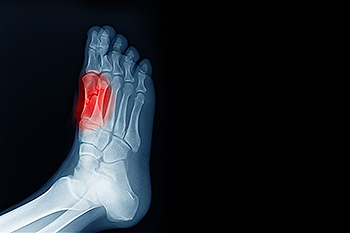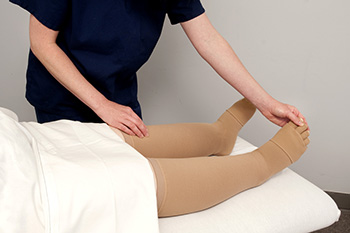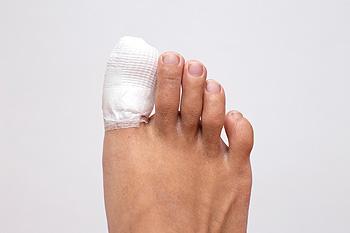
Sesamoiditis is a particular kind of foot affliction that primarily affects the sesamoid bones near the big toe. The sesamoid bones are two small bones located beneath the big toe joint, and when they become inflamed, a condition known as sesamoiditis can develop. There are several ways in which one with sesamoiditis might go about treating this condition. For example, someone with sesamoiditis might try making adjustments to the kind of footwear that they are wearing. Taking this step might help alleviate pain. Opting to wear shoes that have more cushioning in the affected area might be beneficial. Additionally, wearing custom orthotics in the shoes can help further reduce pain and mitigate the condition. Besides making adjustments to the shoes that one wears, one might also consider adjusting their daily physical activities, excluding those that put extra strain on the affected sesamoid bones. Contact a podiatrist today for more information.
Sesamoiditis is an unpleasant foot condition characterized by pain in the balls of the feet. If you think you’re struggling with sesamoiditis, contact one of our podiatrists of Farah Podiatry Associates. Our doctors will treat your condition thoroughly and effectively.
Sesamoiditis
Sesamoiditis is a condition of the foot that affects the ball of the foot. It is more common in younger people than it is in older people. It can also occur with people who have begun a new exercise program, since their bodies are adjusting to the new physical regimen. Pain may also be caused by the inflammation of tendons surrounding the bones. It is important to seek treatment in its early stages because if you ignore the pain, this condition can lead to more serious problems such as severe irritation and bone fractures.
Causes of Sesamoiditis
Treatment for sesamoiditis is non-invasive and simple. Doctors may recommend a strict rest period where the patient forgoes most physical activity. This will help give the patient time to heal their feet through limited activity. For serious cases, it is best to speak with your doctor to determine a treatment option that will help your specific needs.
If you have any questions please feel free to contact our office located in Trenton, MI . We offer the newest diagnostic and treatment technologies for all your foot and ankle needs.

Edema or swelling in the ankles and feet can be an inconvenience or cause severe discomfort and pain. Ways to alleviate edema include continuing to move the affected body parts and elevate the legs above the heart, massaging the swollen areas to push the retained fluid out, and wearing compression socks to facilitate blood flow. The goal of these things is to pump excess fluid back to the heart. Reducing salt intake and dropping extra weight if one is overweight can also help or prevent edema. If the things you try on your own do not relieve the swelling or if the swelling gets worse, it is important that you consult with a podiatrist to find out what is causing the problem and how it can be fixed.
Swollen feet can be a sign of an underlying condition. If you have any concerns, contact one of our podiatrists of Farah Podiatry Associates. Our doctors can provide the care you need to keep you pain-free and on your feet.
Swollen feet are a common ailment among pregnant women and people who stand or sit for extended periods. Aging may increase the possibility of swollen feet and patients who are obese often notice when their feet are swelling too. There may be medical reasons why swollen feet occur:
Swollen feet can also be caused by bone and tendon conditions, including fractures, arthritis, and tendinitis. Additionally, there may be skin and toenail conditions and an infection may cause the feet to swell. Patients who take medicine to treat high blood pressure may be prone to getting swollen feet.
Many patients elevate their feet to help relieve the swelling and this is generally a temporary remedy. When a podiatrist is consulted the reason behind the swelling can be uncovered and subsequently treated.
If you have any questions please feel free to contact our office located in Trenton, MI . We offer the newest diagnostic tools and technology to treat your foot and ankle needs.

Corns of the feet can develop when a specific area of the foot is exposed to a significant amount of pressure or friction. Corns, thickened areas of skin, grow in response. There are many steps that an individual might consider taking to mitigate the effect that corns can have on the health of their feet. One mitigation technique to reduce discomfort from corns is known as corn pads. These pads are shaped like a doughnut and are meant to be adhered to the affected area, with the corn in the center hole. These corn pads are typically made of various materials, including foam and moleskin. Contact a podiatrist today for more information about how corn pads can help you.
If you have any concerns regarding your feet and ankles, contact one of our podiatrists of Farah Podiatry Associates. Our doctors will treat your foot and ankle needs.
Corns: What Are They? and How Do You Get Rid of Them?
Corns can be described as areas of the skin that have thickened to the point of becoming painful or irritating. They are often layers and layers of the skin that have become dry and rough, and are normally smaller than calluses.
Ways to Prevent Corns
There are many ways to get rid of painful corns such as wearing:
Treating Corns
Treatment of corns involves removing the dead skin that has built up in the specific area of the foot. Consult with Our doctors to determine the best treatment option for your case of corns.
If you have any questions please feel free to contact our office located in Trenton, MI . We offer the newest diagnostic and treatment technologies for all your foot and ankle needs.

Although they are relatively small parts of the human body, the toes have different bones that can cause problems when broken. Typically, a broken toe can occur from blunt force trauma or from some kind of stress fracture. If you believe that you have broken your toe, it is best to err on the side of caution and contact a medical professional, such as a podiatrist, to get your injury assessed. It is possible that during this examination the podiatrist will ask you specific questions about the injury. It is also possible that an X-ray examination may be conducted. Besides an X-ray, a medical professional might similarly perform bone scans, an MRI, or a CT scan. This is done to give the practitioner a better sense of the underlying injury and how it affected the bones in the toes. If you suspect a broken toe, schedule an appointment with a podiatrist today.
A broken toe can be very painful and lead to complications if not properly fixed. If you have any concerns about your feet, contact one of our podiatrists from Farah Podiatry Associates. Our doctors will treat your foot and ankle needs.
What to Know About a Broken Toe
Although most people try to avoid foot trauma such as banging, stubbing, or dropping heavy objects on their feet, the unfortunate fact is that it is a common occurrence. Given the fact that toes are positioned in front of the feet, they typically sustain the brunt of such trauma. When trauma occurs to a toe, the result can be a painful break (fracture).
Symptoms of a Broken Toe
Generally, it is best to stay off of the injured toe with the affected foot elevated.
Severe toe fractures may be treated with a splint, cast, and in some cases, minor surgery. Due to its position and the pressure it endures with daily activity, future complications can occur if the big toe is not properly treated.
If you have any questions please feel free to contact our office located in Trenton, MI . We offer the newest diagnostic and treatment technologies for all your foot and ankle needs.

Many individuals might be surprised to learn that their alcohol consumption can actually have a negative effect on the health of their feet. For example, excessively drinking alcohol can be dangerous for those who are suffering from gout in the feet. Gout is a kind of arthritis that can manifest symptoms in the feet. Gout is essentially triggered by uric acid, which is produced when the body is in the process of breaking down purines. Since alcohol, specifically beer, can contain many purines, someone can exacerbate their gout if they drink high quantities of beer. If you are someone living with gout and you frequently experience gout flares, it might be a good idea to schedule an appointment with a podiatrist who will help you manage these symptoms.
Gout is a painful condition that can be treated. If you are seeking treatment, contact one of our podiatrists from Farah Podiatry Associates. Our doctors will treat your foot and ankle needs.
What Is Gout?
Gout is a form of arthritis that is characterized by sudden, severe attacks of pain, redness, and tenderness in the joints. The condition usually affects the joint at the base of the big toe. A gout attack can occur at any random time, such as the middle of the night while you are asleep.
Symptoms
Risk Factors
Prior to visiting your podiatrist to receive treatment for gout, there are a few things you should do beforehand. If you have gout you should write down your symptoms--including when they started and how often you experience them, important medical information you may have, and any questions you may have. Writing down these three things will help your podiatrist in assessing your specific situation so that he or she may provide the best route of treatment for you.
If you have any questions, please feel free to contact our office located in Trenton, MI . We offer the newest diagnostic and treatment technologies for all your foot care needs.